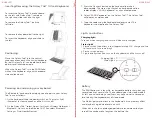
3. Panels
3.1. Power Supply Connector
+
24 V ....................... DC
+
24
V terminal.
0 V ............................ DC 0
V terminal.
FG (SHLD/SLD) ........ Ground terminal.
(Connector shield of all are connected inside with FG. )
3.2. Sensor Terminals of Load Cell
SIG
-
........ The (
-
) input terminal of signal that is outputted
from load cell.
SIG
+
........ The (
+
) input terminal of signal that is outputted
from load cell.
EXC
-
...... The (
-
) output terminal for load cell excitation
voltage (
-
).
SEN
-
...... The (
-
) input terminal for sensing input (
-
). (When performing the 4-wire
connection, connect between EXC- and SEN-.)
SEN
+
...... The (
+
) input terminal for sensing input (
+
). (When performing the 4-wire
connection, connect between EXC+ and SEN+.)
EXC
+
...... The (
+
) output terminal for load cell excitation voltage (
+
).
SHLD
...... Connect shield of sensor cable.
Connections
When connecting and removing the cables, push the buttons with a driver etc.
We recommend use of rod type crimp terminals for the tips of cables.
3.3. Control I/O, C.L.Output, D/A OUT and Micro-B USB
Terminals of control I/O is isolated from load cell
and power supply (POWER).
Supply D.C. +24 V between PWR+24V terminal and
COM terminal.
(MDR connector with 20 pins, manufactured by 3M).
C.L.(current loop) output circuit is isolated from other
terminals.
(MDR connector with 20 pins, manufactured by 3M.)
For analog output (D/A OUT), use analog 4-20mA
output connector that is a power clump connector
(A type) manufactured by 3M.
Use
standard
Micro
-
B USB connector for USB so that
the function settings can be read and written.
AD-4430A
DIN Rail Weighing Module
With Analog (4-20mA) Output
Simplified Instruction Manual
Refer to the instruction manual on the A&D home page.
URL: http://www.aandd.jp/
1WMPD4003452
This Manual
This manual describes how the product works and how to get the most out of
it in terms of performance. Read this manual thoroughly before using the
product and keep it at hand for future reference.
Product specifications are subject to change without any obligation on the
part of the manufacturer to notify of changes.
This manual is subject to change without notice at any time to improve the
product. No part of this manual may be photocopied, reproduced, or translated
into another language without the prior written consent of the A&D Company,
limited.
2017
All rights reserved.
3-23-14 Higashi-Ikebukuro, Toshima-ku, Tokyo 170-0013, JAPAN
Telephone: [81] (3) 5391-6132
Fax: [81] (3) 5391-6148
1. Cautions
1.1.
Installation and Precautions
Before use, confirm the following articles for safe operation.
Avoid vibration, shock, extremely high temperature and humidity, direct
sunlight, dust, splashing water, air containing salt or corrosive gases, places
where inflammable gases are present.
The operating temperature is -10°C to +50°C (14°F to 122°F).
Ground the module.
Keep cables away from power cables and other sources of electrical noise.
Use a stable DC24 V power source that does not include step down voltage
and noise.
Do not share the earth ground line and power line with other electrical power
equipment.
When extending the load cell cable, separate it from the power cable and
electrical cables with much noise.
Do not turn on the module until installation is complete. The module is not
equipped with a switch to turn off.
After the installation is complete, take off the protective cover prior to turning on
the AD-4430A.
Use a shielded load cell cable.
Do not connect more sensors than the allowable number noted in the specifications.
1.2.
Cautions During Use
The AD
-
4430A is a precision instrument that measures micro-volt output from load
cell. Prevent noise sources such as power lines, radios, electric welders or motors
from affecting the instrument.
Do not disassemble the AD
-
4430A.
2. General Specifications
Voltage requirement
DC 24 V +10%, -15%
Power requirement
6 W Max.
Load cell power supply DC 5 V 350
sensor. Up to 4 load cells can be connected.
Operating conditions
-
10 °C to
+
50 °C, Max 85 %RH (no condensation)
External dimensions
Mass
35.3 × 110.0 × 101.3 mm (W×H×D)
Approximately 200 g
Monitor
The monitor displays measurement data and settings with
7 segments of 5 digits and negative sign. The decimal point
is specified at the function table.
Accessory
RS-485 connector (manufactured by 3M)
35505-6200-A00 GF (1 piece)
4.1.1. Zero
Calibration
Step 3 Press
the
key to display
.
When skipping zero calibration, press the
key and proceed to step 5.
Step 4 Confirm that the LED is lit and press the
key. Then
is displayed for 2 seconds. When canceling span calibration and
returning to weighing mode, press the
key twice.
4.1.2. Span
Calibration
Step 5 When
is displayed, press the
key. The current calibration
weight value is displayed. A figure flashes. Specify a new value using the
and keys. When canceling span calibration and returning to
weighing mode, press the
key twice.
Step 6 Place the mass on the weighing pan. Confirm that the LED is lit and
press the
key. Then
is displayed for 2 seconds.
Step 7 When
is displayed, remove the mass from the weighing pan.
When repeating span calibration, press the
key.
Step 8 Press
the
key. Then
is displayed and calibration data is
stored in the nonvolatile memory (FRAM) of the AD
-
4430A.
Step 9 Press
the
key to return to weighing mode.
4.2. Digital Linearization
(
)
Digital linearization is the non-linearity compensation function that can rectify or
reduce linearity deviation between zero point and weighing capacity.
Up to four points can be specified except zero. (Refer to
)
Relationship of points : Zero =
<
<
<
<
The high-order correction curve is used so that zero point and individual points
are arranged in a straight line.
Digital linearization includes span calibration.
Step 1 When turning off the display using pressing and holding the
key,
press the key and the
key ( +
key). Then
of
calibration mode is displayed. Press the
key to display
.
Step 2 Press
the key to select
and press the
key to enter
digital linearization.
Step 3
of the zero point is displayed.
Step 4 While LED is displayed, press the
key to store the weighing
value. Then
is displayed for 2 seconds.
Step 5 When
displaying
, press the
key to select a weight value.
Specify it using the
and key.
Step 6 Place the weight on the pan. While LED is displayed, press the
key to store the weighing value. Then
is displayed for 2 seconds.
Step 7
is displayed. Repeat the same operation as Step 5 and Step 6 at
the second point.
Step 8
is displayed. Repeat the same operation as Step 5 and Step 6 at
the third point.
Step 9
is displayed. Repeat the same operation as Step 5 and Step 6
at the fourth point.
Step 10
is displayed. Press the
key to store new parameters into
nonvolatile memory (FRAM) and display
.
Step 11 Press
the
key to return to weighing mode. Remove all of weight
from the pan.
4.3. Calibration Errors
(
)
Display
Cause Treatment
The display resolution
(maximum capacity / minimum
division) exceeds the specified
value.
Make the minimum division greater or
make the weighing capacity smaller. The
specified value depends on specifications
of the weighing system.
Voltage at zero calibration
exceeds in the positive direction.
Voltage at zero calibration
exceeds in the negative
direction.
Check the load cell rating and
connection. When nothing is wrong with
the rating and connection, adjust the load
cell output. When the load cell or A/D
converter may be the cause of error,
confirm this by using the check mode.
The value of the calibration
weight exceeds the maximum
capacity.
The value of the calibration
weight is less than the minimum
division.
Use an appropriate calibration weight
and calibrate again.
The load cell sensitivity is not
sufficient.
Use a load cell with higher sensitivity or
make the minimum division greater.
Voltage at span calibration is less
than voltage at the zero point.
Check the load cell connection.
The load cell output voltage is too
high when the mass of
maximum capacity is weighed.
Use a load cell with a greater rating or
make the weighing capacity smaller.
3.4. Status Indicator
LED
Description
Gross :
LED lights when indicating gross value.
Net :
LED lights when indicating net value.
Hold :
LED lights when the hold function operates.
Stable :
LED lights when the current weighing value is stable.
Zero :
LED lights when the weighing value is center zero.
This LED works by selected function at
.
3.5. Keys
Operation
Mode
Function
Weighing
The function key works by selected function at
fnc 02
.
In the factory setting, select total weight or net weight.
Setting The
escape
key
Weighing
"The zero key" to perform the zero operation.
Setting
The key to move a digit.
Weighing
"The tare key" that displays zero for net weighing.
Setting
The key to select parameter or increase number.
Weighing
Press and hold the key to turn off the display in weighing mode.
OFF
Press the key to turn on the display in standby.
Setting
The enter key
Weighing
The function key
Setting
The escape key
+
Weighing
Proceeds to the function mode from the weighing mode.
+
Setting
Proceeds to the check mode from the function mode.
+
OFF
Proceeds to the calibration from standby (at OFF mode).
3.6. Operation Mode
Function mode .............................................................. (In weighing mode,
+ )
The
condition
of
the
AD
-
4430A can be updated and be stored.
Check mode .................................................................... (In function mode,
+
)
The mode to check the AD
-
4430A.
Calibration mode .............................................. (When display is turned off, +
)
The mode to calibrate zero point and span of the AD
-
4430A by calibration weight or input
value.
4. Calibration
The
AD
-
4430A measures the voltage of the load cell and displays it. Calibration corrects
the signal from the load cell to convert into mass correctly.
※
Specify "decimal point position (
)", "minimum division (
)" and "weighing
capacity (
)" in function mode.
※
Calibrate (adjust) "input voltage at zero (
)", "span calibration input voltage (
)"
and "weight against span calibration input voltage(
)" using the "span calibration using
mass (
)" in calibration mode. These items can be also inputted using "digital span" in
function mode.
※
Perform stable measurement in the calibration to prevent measurement error.
※
During a stable measurement, the LED lights.
※
The flashing decimal point means "no weighing value" in calibration mode.
※
When
and a number are displayed, an error has occurred.
Refer to "Calibration Errors" for details.
※
Before the calibration, turn on the AD
-
4430A more than 10 minutes so as to avoid
temperature drift (change).
4.1. Span Calibration using Mass
(
)
Preset a unit, decimal point, minimum division and weighing capacity in function mode.
The span calibration is performed using mass of the weighing capacity.
Step 1 When turning off the display using pressing and holding the
key, press the key
and the
key ( +
key). Then
of calibration mode is displayed.
Step 2 Press
the
key to enter calibration mode.
is displayed. When returning to weighing mode, press the
key.
-
1
-
-
2
-
-
3
-
-
4
-
Pull down when removing.
Hook for DIN rail
Vent
Vent
Monitor
3.4. Status Indicator
3.5. Keys
3.2. Sensor Terminals of
Load Cell
3.1. Power supply connector
3.3. Control I/O and C.L. output
3.3. USB connector
3.3. D/A OUT connector
Guide for DIN rail
Rod type crimp terminal
Load cell cable
Power cable
Push button to pull out the cable.
Load cell tag




















